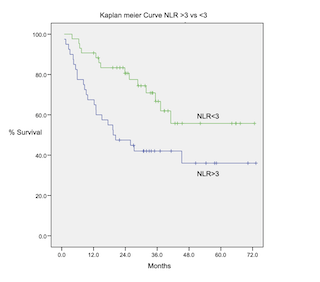
Contributions
Abstract: PB1438
Type: Publication Only
Session title: Aggressive Non-Hodgkin lymphoma - Clinical
Background
Diffuse Large Cell Lymphoma B (DLBCL) accounts for up to 62% of all Non-Hodgkin Lymphomas. The prognosis of DLBCL is established by considering patient and tumor factors. Neoplasm cells develop immune escape mechanisms in addition to an inflammatory response associated with Cancer. Tumor cells recruit Tumor Associated Neutrophils (NAT) that exert pro-carcinogenic effects such as inhibition of tumor cell apoptosis, angiogenesis, and suppression of the adaptive immune system.
Aims
To assess the impact on Overall survival of NLR in patients with a diagnosis of DLBCL
Methods
We aimed an observational, retrospective, cross-sectional and analytical study. Patients with Diffuse Large B-Cell Lymphoma, diagnosed between January 2014 and December 2018 were included. The qualitative variables were analyzed with the chi-square test and the quantitative variables with the student's t test. The relative risk was measured with a 95% CI, with a p value <0.05% being significant. A survival analysis was performed with Kaplan-Meier curves.
Results
83 patients were included, 51 (61.4%) were men and 32 (38.5%) were women, with a median age of 61 (range 26-85) years and a median follow-up of 27 (range 0.9-73.2) months. Patients with NLR >3 was associated with lower response to chemo immunotherapy (p=0.001), higher relapse/refractive disease (P=0.003) and more than two lines of treatment (p=0.016) . NLR >3 was associated with lower survival with HR 2.36( p=0.011). The Overall Survival at 6 years of patients with NLR> was 36% compared to those with NLR <3 was 56% (p = 0.009).

Conclusion
The NLR >3 is a predictor of a lower response to immunochemotherapy and more agresive course in addition to being associated with a lower overall survival in patients with DLBCL.
Keyword(s): Lymphoma, Neutrophil, Prognosis, Survival
Abstract: PB1438
Type: Publication Only
Session title: Aggressive Non-Hodgkin lymphoma - Clinical
Background
Diffuse Large Cell Lymphoma B (DLBCL) accounts for up to 62% of all Non-Hodgkin Lymphomas. The prognosis of DLBCL is established by considering patient and tumor factors. Neoplasm cells develop immune escape mechanisms in addition to an inflammatory response associated with Cancer. Tumor cells recruit Tumor Associated Neutrophils (NAT) that exert pro-carcinogenic effects such as inhibition of tumor cell apoptosis, angiogenesis, and suppression of the adaptive immune system.
Aims
To assess the impact on Overall survival of NLR in patients with a diagnosis of DLBCL
Methods
We aimed an observational, retrospective, cross-sectional and analytical study. Patients with Diffuse Large B-Cell Lymphoma, diagnosed between January 2014 and December 2018 were included. The qualitative variables were analyzed with the chi-square test and the quantitative variables with the student's t test. The relative risk was measured with a 95% CI, with a p value <0.05% being significant. A survival analysis was performed with Kaplan-Meier curves.
Results
83 patients were included, 51 (61.4%) were men and 32 (38.5%) were women, with a median age of 61 (range 26-85) years and a median follow-up of 27 (range 0.9-73.2) months. Patients with NLR >3 was associated with lower response to chemo immunotherapy (p=0.001), higher relapse/refractive disease (P=0.003) and more than two lines of treatment (p=0.016) . NLR >3 was associated with lower survival with HR 2.36( p=0.011). The Overall Survival at 6 years of patients with NLR> was 36% compared to those with NLR <3 was 56% (p = 0.009).

Conclusion
The NLR >3 is a predictor of a lower response to immunochemotherapy and more agresive course in addition to being associated with a lower overall survival in patients with DLBCL.
Keyword(s): Lymphoma, Neutrophil, Prognosis, Survival


